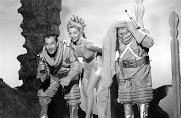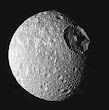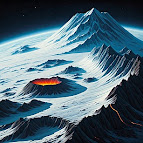The Pootler's Guide to Alien Worlds
I've been around a while. When I was a kid, thanks to giant telescopes, we knew that the moon was not made of green cheese but was grey, arid and cratered. When it came to objects further away, we were ignorant. Cue vivid imagining of other worlds for vinyl album covers, TV and film sets and drawings in comics. Limited budgets for TV shows like Doctor Who and Lost in Space used studio 'landscapes' with flat floors, painted landscapes and polystyrene rocks. Realism was understandably not a priority for album covers, and comics were concerned with filling every frame with action. Whap! Zoom!
 |
| Lost in Space. Mid 1960's |
In 1969, Apollo 11 confirmed that the moon was indeed grey, arid and cratered, and I had ditched those comics for sci-fi novels while film budgets had ballooned, but few had pretensions to realism simply because we had no idea what 'real' was when it came to other planets. So how did they depict them?
 |
| 'Yes' Album Cover 1973 |
I will focus first on films simply because you don’t see many LP covers or comics these days. I am not a screen buff, so aficionados and pedants might pick a quarrel with what follows. No matter, my pen, my rules. The earliest screen creations were constrained by limited budgets and technology. But that didn't stop them. In 1953, even Abbott & Costello made it to the moon.
 |
| Abbott and Costello Go To Mars 1953 |
In nearly every case, when the crew ventured out of the studio with its ersatz scenery, the landscape usually looked remarkably similar to the deserts around California. Rocky with red sand and sunny skies, got that. Even here in Britain, not noted for its sun and sand, they took what they could find, so alien planets had oak trees, gorse and chalk quarries.
 |
| Dr Who & The Daleks1960's |
By the turn of the millennium, Hollywood had the means to travel further in search of places exotic enough to look otherworldly. The definitive 2001 A Space Odyssey was mostly shot in studios around London, but the big landscape scenes were mostly shot in Namibia, while the alien planet on the other side of the Stargate was a cleverly mangled mash-up of Monument Valley and the South Hebrides.
 |
| 2001 Space Odyssey : Namibia |
Generally, CGI technology has increasingly added to what was possible and used to augment natural settings. Marvel’s Deadpool and Wolverine is a recent example. Again, a lot of it was created in studios around London (and in this case at Bovingdon Airfield near Hemel). In contrast, some went far afield. The icy scenes in Star Wars 'The Empire Strikes Back' were filmed in the Hardangervidda in Norway.
 |
| Star Wars : Hardangervidden |
Avatar went much further still, using magical spots in China, Venezuela, New Zealand and the Caribbean. Might other worlds look like that? It seems highly unlikely, but still less improbable than a world of polystyrene and flat flooring for aliens with mobility issues.
| Avatar :_Zhangjiajie & Wulingyuan. China.jpg |
The arrival of sci-fi video games introduced a new medium. I am not a gamer, but I looked at No Man’s Sky and screenshots from several others as exemplars. Here, the landscapes are mainly designed to be interactive playgrounds where the laws of physics are suspended and accommodations made for alien life forms.
Interestingly, when you ask AI to create a view of another planet, it comes up with something akin to game designs. In this one area where you want a bit more science and a bit less fantasy, it fantasises.
 |
| AI (Aria) |
After 1969, it was widely assumed that the scientists' next step would be a base on the moon, which might serve as a starting point for wider exploration. That didn’t seem to be worth the candle, so the real step change came with the fleets of (cheaper and safer) satellite probes, sent to sniff around the solar system.
The various landers on Mars have produced some wonderful pictures of what it really looks like. The place to go for all this stuff is the NASA website, a real treasure trove. See: Nasa Planets. So now we know that Mars's surface, like ours, was almost certainly heavily sculpted by volcanoes and water in the past, with some of the latter still present in the polar ice caps. If it ever harboured life, that was aeons ago, and a major difference now is a much thinner atmosphere, which offers little protection from meteors.
| NASA : Mars 'Curiosity' Rover 2023 |
 |
| More Mars |
 |
| 'The Martian' in Wadi Rum |
Mars might be the place for you if you like climbing. Olympic Mons is well over twice as high as Everest, but comes without snow and as much gravity, so the oxygen tanks won't feel as heavy. It's not for me, though. I blame the arthritis as well as sloth. Maybe the beach? Evidence from a Chinese rover suggested "ancient beaches and ancient river deltas......wind, waves, no shortage of sand, a proper, vacation-style beach"
Venus is Earth's evil twin and was mostly ‘probed’ 40 years ago by the USSR. The photography is understandably less impressive. You can see every photo ever taken here. Venus
 |
| Venus |
Not exactly brochure food, you will agree, and they don’t tell us much, because they only covered a small area and the surface is so hot that the lander would have melted. The atmosphere of sulphuric acid wouldn’t help either; if you were stupid enough to try and sniff the air, you would barely detect rotten eggs before your head boiled. But it isn’t all gloom with the doom. Some light gets through to the surface, probably giving it as much illumination as those old, underpowered yellow street lamps.
So much for our near neighbours, but once you go beyond them, our ignorance is such that plausibility isn't a practical priority and the background landscape can be treated as, well, the background, with the added problem of how to represent aliens! Of course, you can simply ignore the issue as they did when depicting the dominant Venusian women in the 1958 film ‘The Queen of Outer Space’, starring the diva Zsa Zsa Gabor.
 |
| Venus : 'The first female planet' |
Within our neighbourhood, there are 5 other ‘full fat’ planets and literally thousands of other objects ranging from demoted Pluto down to 6 other dwarf planets and over 300 moons and odd-shaped lumps, some classified as comets or asteroids. When I was a kid, Pluto was the limit, and we did not know whether any other star had planetary companions. Now, with the new kit both on the ground and in orbit, we can extend our gaze both within and beyond the visible spectrum.
So, how far do the media visions depart from what we now know about the scenery on the other planets? And I stress ‘scenery’. I am interested here in what you can see and feel rather than the science. This is not so much press-ups for the intellect as yoga for the imagination.
 |
| Yogic Flying? |
Our other neighbourhood companions first. If you want a landscape to stroll around, you won’t be interested in our larger local planets, simply because they don’t have one, or at any rate one with a visible, solid surface. Jupiter, Saturn and Uranus are heavily cloaked in poison gases. gas giants. You might enjoy a fly-by, particularly past the roiling cloudscapes and Saturn's rings, but beyond that, if there is something recognisably solid in their middle, we can’t get at it. In fact, Saturn is candy floss. According to NASA, if you had a pool big enough, it would float.

Neptune is also covered in deep clouds of gas, and while it is a lovely shade of blue, it is also the coldest and windiest place in the solar system. Frankly, your Gore-Tex isn't up to the job. But it is possible that deep down there is a sea of ammonia and methane-flavoured water, so those 1500 mph winds might make for interesting yachting.
The exception is tiny Mercury, which probably looks a bit like the moon; grey, desolate and peppered with craters. The main difference is that it always keeps the same side to the sun, so it bakes while the other side freezes. This would lend itself to an interesting and probably terrifying weather pattern if it had anything resembling a proper atmosphere. But it hasn’t.
Most of the better (least bad) places to visit in the outer solar system are the moons. Nearly all of them are just ice balls, distorted by the gravity of their bullying planet and lacking any atmosphere to protect them from meteors.
Heading outwards, an exception is Io, the innermost of Jupiter’s brood and roughly the same size as our moon. Even though the thermometer hovers around -150°C, it appears to be ice-free. Instead, tides pulling and pushing within its rocky surface have created a volcanic mess, with a delicious and colourfully decorated sulphurous topping. In place of ice white and more white, you would experience an autumnal palette of yellows, browns and dark reds, marked by immense lakes and fountains of lava and strange and changing outcrops of sulphur. This artist's impression will give you some idea! Wear a hat.
 |
| Io ? |
Another of Jupiter’s moons suffers from the gravity issue with a different result. Callisto has a severe pox of craters, not least because Jupiter keeps pulling in objects that crash into it.
Moving out, Titan is the Donald Trump of Saturn's moons. Orange and gaseous; it is the only moon with an atmosphere. It's mostly Nitrogen, as is ours, but you wouldn't want to swap. We have oxygen as well, Titan only adds methane, which forms lakes, rivers and rain at these low temperatures. It also has huge dunes, not of sand but hydrocarbons and (NASA says) probably the colour and texture of coffee grounds. It is supposedly the most earthlike (or least earth-unlike) of all of these bodies. Everything is relative!
 |
| Titan ? |
Enceladus has huge geysers of water ice bursting through its thin surface crust. It has become a target for those hunting for any flicker of life, while Iapetus has ended up shaped like a walnut thanks to a circling ridge that is higher than the Himalayas.
| Probe Photo / Water plumes on Enceladus. |
 |
| Ditto: Artists Impression |
Hyperion wobbles like a drunk in its orbit and seems to be hollow or at least built like a sponge; it is only half as dense as water. Finally, tiny Mimas knocked people back when they first saw it. It is a 'lookalike' of Darth Vader’s Death Star.
 |
| Mimas |
 |
| The Death Star |
Further out, Miranda scuttles around Uranus. It has a surface area roughly the same as the UK and looks like it has been assembled from a kit of disparate parts, some smooth and others heavily splintered and pockmarked. Its appeal to tourists is not obvious, but it might appeal to ice-wall climbers with a cliff well over twice the height of Mt Everest.
Neptune’s biggest moon is Triton. It sports a thin atmosphere and winks sometimes. So maybe it is friendly.
Elsewhere in the system, I suppose you could land on an asteroid or comet, but they do seem to be mostly lumps of rock that would reward a fly past rather than a visit. Some are entertaining shapes, including a raw peanut, a dildo and a skull.
 |
| 2015 TB145 |
 |
| 25143 Itokawa |
When Apollo landed, we still didn’t know whether our planetary system was unique or not. Now we know they are ubiquitous. NASA reckons that we know of 5,600 ‘Exoplanets’ within our own galaxy alone and suspect that there are billions more. They are a very, very long way away, and as you know, we are very bad at comprehending very small and very large numbers. No matter, onward to the stars.
The nearest 4 light-years away and I reckon that, at my usual cycling pace and allowing for evenings in the pub and weekends off, it would take me around 2bn years to get there. Most exoplanets are very much more 'exo' than that, so what we know about them is not shaped by what we can see but rather what can be deduced from our knowledge of astrophysics and chemistry. I am in awe of the science, but as it stands, these are hypothetical landscapes!
In what follows, a lot of what we (they? Not me in any event) know reflects our understanding of things like the orbit and rotation speed of a planet and the chemical makeup of its atmosphere. If you (forgiveably) haven’t heard of the use of Doppler Shift in Astronomy, I won’t explain it. Look it up. Also, I will bung-in the IDs of the various planets (for an excusable lack of close-up photos!) to show that I am not making this up, and the reference names are links to the NASA or other reputable sources, some are video visualisations. How about:
A lovely blue planet with a hot, spinning atmosphere probably resulting in a never-ending horizontal rainstorm of glass. HD189773b
A giant gas planet, hot enough to have clouds made of quartz crystals. The light show from the surface (if there is one) should be sensational. Wasp-17b You might also get a great rainbow-coloured light show known as a 'glory' on this planet. But watch out when it rains iron. WASP-76b
The lookalike of Luke Skywalker’s home planet in Star Wars. It circles around two stars. So they call it Tatooine. For more on that, try Wookiepedia. Kepler-16b
Have you read 'The Three-Body Problem’? Maybe this galactic snooker table solves it. It is so odd that you might want to look further, so here is a link: GW Orionis system
 |
| Artists Impression: GW Orionis |
The Barbarella planet. Pure pink. GJ504b:
Twice the size of Earth and probably covered in graphite and diamond rather than water and granite. It has been valued at £22 nonillion or roughly 300 quadrillion times the entire value of Earth’s GDP. 55Cancri e
This is in the Constellation of Monoceros, which might be a Chthonian planet, where the clouds of gas have disappeared to leave just a rocky core. I mainly like it because it sounds like something out of Dr Who and H P Lovecraft used the name for his space monsters. It should be hot enough to vaporise that rock, which could then condense to make rocky rain. CoRoT-7b
A planet that always shows the same face to its star. An atmosphere with iron and titanium, hot enough to tear molecules apart. Kelt9B. Meanwhile, Kelt 11b is absolutely massive but has the density of styrofoam.
Think of the darkest colour you have ever seen. Then darker. But then how can you see it all? TrES-2b
Finally, a planet that might, just, just be habitable, and I am including it so that Elon doesn't get discouraged. It has an ocean surrounded by an ice sea. LHS-1140b
The fact is, we have not yet seen anywhere that is much like our planet or solar system. That doesn't mean that there are none, just that our capabilities are very, very far from being up for the search and at least water in some form seems common enough which encourages the astrobiologists.
And as it stands, our boldest probe will not reach the nearest star for 16,000 years. So put your dreams of interplanetary tourism aside for a bit and just let your imagination wander, not least because it will probably do a better job of dodging the heat, the cold, the rivers of lava, body-crushing gravity, poison clouds, winds and horizontal flying glass from the safety of the snug in the Red Lion. Or away for Mr Vader in Chalmun's Spaceport Cantina. If you know how to drink while wearing a space helmet, please let me know.








